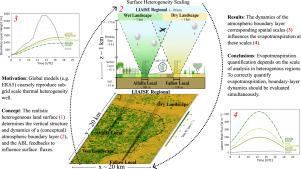Agricultural and Forest Meteorology ( IF 5.6 ) Pub Date : 2023-04-14 , DOI: 10.1016/j.agrformet.2023.109452 Mary Rose Mangan , Oscar Hartogensis , Aaron Boone , Oliver Branch , Guylaine Canut , Joan Cuxart , Hugo J. de Boer , Michel Le Page , Daniel Martínez-Villagrasa , Josep Ramon Miró , Jeremy Price , Jordi Vilà-Guerau de Arellano

|
Irrigation in semi-arid regions induces thermal heterogeneity across a range of spatial scales that impacts the partitioning of energy at the surface, the development of the atmospheric boundary layer, and the bidirectional interactions between the atmosphere and the surface. In this analysis, we use data from the Land Surface Interactions with the Atmosphere in the Iberian Semi-Arid Environment (LIAISE) experiment combined with a coupled land–atmosphere model to understand the role of the scales of irrigation-induced, thermal heterogeneity on the surface fluxes and consequently, the development of the diurnal convective boundary layer. The surface heterogeneity is characterized by Bowen ratios that range from 0.01 in the irrigated areas to 30 in the non-irrigated areas; however, the observed boundary-layers dynamics in both locations are similar. In this analysis, we address the questions of how the surface fluxes impact the development of the boundary-layer dynamics and how the boundary layer influences the diurnal cycle of surface fluxes. To interpret the observations, we introduce a heterogeneity scaling scheme where length scales range from local scale (100 m) to regional scale (10 km) to investigate the role of scale on surface representation in numerical models and to address the discrepancy between surface observations and their representation in weather and climate models.
We find that at the surface, both the available energy and its partitioning depend on spatial scale. The observed boundary-layer properties can be explained through the composite of surface fluxes at the regional scale. Surface fluxes at the local scales are unable to replicate the observed boundary layer — even when including large-scale contributions. We find that non-local boundary layer processes like advection are important for partitioning energy at the local scale. We explore the connection between surface fluxes and the development of the boundary layer and the potential non-local effects on boundary-layer development.
中文翻译:

灌溉驱动的热异质性跨空间尺度的表面边界层连接:LIAISE 实地活动的综合数据和建模研究
半干旱地区的灌溉会在一系列空间尺度上引起热异质性,从而影响地表能量的分配、大气边界层的发展以及大气与地表之间的双向相互作用。在此分析中,我们使用来自伊比利亚半干旱环境中地表与大气相互作用 (LIAISE) 实验的数据,并结合耦合的陆地-大气模型来了解灌溉引起的热异质性规模对表面通量,因此,昼夜对流边界层的发展。表面异质性的特征是 Bowen 比率范围从灌区0.01至非灌区30个;然而,在这两个位置观察到的边界层动力学是相似的。在此分析中,我们解决了地表通量如何影响边界层动力学的发展以及边界层如何影响地表通量的昼夜循环的问题。为了解释观察结果,我们引入了一种异质性缩放方案,其中长度尺度范围从局部尺度(100 m) 到区域尺度 (10 公里)调查尺度对数值模型中地表表示的作用,并解决地表观测与其在天气和气候模型中的表示之间的差异。
我们发现在表面,可用能量及其分配都取决于空间尺度。观察到的边界层特性可以通过区域尺度的表面通量组合来解释。局部尺度的表面通量无法复制观察到的边界层——即使包括大尺度贡献也是如此。我们发现像平流这样的非局部边界层过程对于局部尺度的能量分配很重要。我们探讨了表面通量与边界层发展之间的联系,以及对边界层发展的潜在非局部影响。










































 京公网安备 11010802027423号
京公网安备 11010802027423号